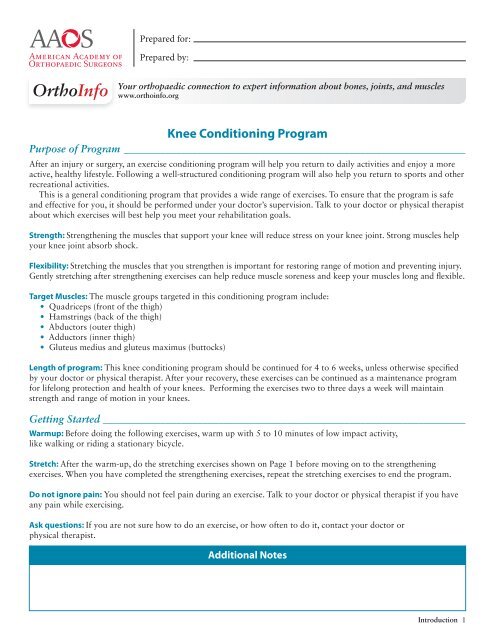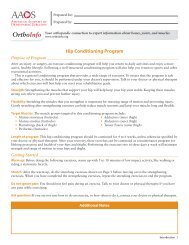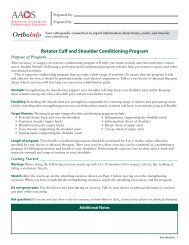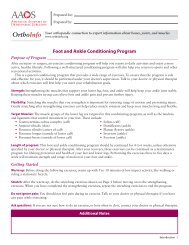Knee Conditioning Program - AAOS - American Academy of ...
Knee Conditioning Program - AAOS - American Academy of ...
Knee Conditioning Program - AAOS - American Academy of ...
You also want an ePaper? Increase the reach of your titles
YUMPU automatically turns print PDFs into web optimized ePapers that Google loves.
OrthoInfo<br />
Prepared for:<br />
Prepared by:<br />
Your orthopaedic connection to expert information about bones, joints, and muscles<br />
www.orthoinfo.org<br />
<strong>Knee</strong> <strong>Conditioning</strong> <strong>Program</strong><br />
Purpose <strong>of</strong> <strong>Program</strong> _________________________________________________________________<br />
After an injury or surgery, an exercise conditioning program will help you return to daily activities and enjoy a more<br />
active, healthy lifestyle. Following a well-structured conditioning program will also help you return to sports and other<br />
recreational activities.<br />
This is a general conditioning program that provides a wide range <strong>of</strong> exercises. To ensure that the program is safe<br />
and effective for you, it should be performed under your doctor’s supervision. Talk to your doctor or physical therapist<br />
about which exercises will best help you meet your rehabilitation goals.<br />
Strength: Strengthening the muscles that support your knee will reduce stress on your knee joint. Strong muscles help<br />
your knee joint absorb shock.<br />
Flexibility: Stretching the muscles that you strengthen is important for restoring range <strong>of</strong> motion and preventing injury.<br />
Gently stretching after strengthening exercises can help reduce muscle soreness and keep your muscles long and exible.<br />
Target Muscles: The muscle groups targeted in this conditioning program include:<br />
• Quadriceps (front <strong>of</strong> the thigh)<br />
• Hamstrings (back <strong>of</strong> the thigh)<br />
• Abductors (outer thigh)<br />
• Adductors (inner thigh)<br />
• Gluteus medius and gluteus maximus (buttocks)<br />
Length <strong>of</strong> program: This knee conditioning program should be continued for 4 to 6 weeks, unless otherwise speci ed<br />
by your doctor or physical therapist. After your recovery, these exercises can be continued as a maintenance program<br />
for lifelong protection and health <strong>of</strong> your knees. Performing the exercises two to three days a week will maintain<br />
strength and range <strong>of</strong> motion in your knees.<br />
Getting Started _____________________________________________________________________<br />
Warmup: Before doing the following exercises, warm up with 5 to 10 minutes <strong>of</strong> low impact activity,<br />
like walking or riding a stationary bicycle.<br />
Stretch: After the warm-up, do the stretching exercises shown on Page 1 before moving on to the strengthening<br />
exercises. When you have completed the strengthening exercises, repeat the stretching exercises to end the program.<br />
Do not ignore pain: You should not feel pain during an exercise. Talk to your doctor or physical therapist if you have<br />
any pain while exercising.<br />
Ask questions: If you are not sure how to do an exercise, or how <strong>of</strong>ten to do it, contact your doctor or<br />
physical therapist.<br />
Additional Notes<br />
Introduction 1
OrthoInfo<br />
Your orthopaedic connection to expert information about bones, joints, and muscles<br />
www.orthoinfo.org<br />
<strong>Knee</strong> <strong>Conditioning</strong> <strong>Program</strong><br />
STRETCHING EXERCISES<br />
1. Heel Cord Stretch ________________________________________________________________<br />
Repetitions<br />
2 sets <strong>of</strong> 4<br />
Days per week<br />
6 to 7<br />
2. Standing Quadriceps Stretch _______________________________________________________<br />
Repetitions<br />
2 to 3<br />
Days per week<br />
4 to 5<br />
Main muscles worked: Gastrocnemius-soleus complex<br />
You should feel this stretch in your calf and into your heel<br />
Equipment needed: None<br />
Step-by-step directions<br />
• Stand facing a wall with your unaffected leg forward with a slight bend at the<br />
knee. Your affected leg is straight and behind you, with the heel at and the<br />
toes pointed in slightly.<br />
• Keep both heels at on the oor and press your hips forward toward the wall.<br />
• Hold this stretch for 30 seconds and then relax for 30 seconds. Repeat.<br />
Tip Do not arch your back.<br />
Main muscles worked: Quadriceps<br />
You should feel this stretch in the front <strong>of</strong> your thigh<br />
Equipment needed: None<br />
Step-by-step directions<br />
• Hold on to the back <strong>of</strong> a chair or a wall for balance.<br />
• Bend your knee and bring your heel up toward your buttock.<br />
• Grasp your ankle with your hand and gently pull your heel closer to your body.<br />
• Hold this position for 30 to 60 seconds.<br />
• Repeat with the opposite leg.<br />
Tip Do not arch or twist your back.<br />
© <strong>American</strong> <strong>Academy</strong> <strong>of</strong> Orthopaedic Surgeons Exercises Page 1
OrthoInfo<br />
Your orthopaedic connection to expert information about bones, joints, and muscles<br />
www.orthoinfo.org<br />
<strong>Knee</strong> <strong>Conditioning</strong> <strong>Program</strong><br />
STRETCHING EXERCISES<br />
3. Supine Hamstring Stretch __________________________________________________________<br />
Repetitions<br />
2 to 3<br />
Days per week<br />
4 to 5<br />
Main muscles worked: Hamstrings<br />
You should feel this stretch at the back <strong>of</strong> your thigh and behind your knee<br />
Equipment needed: None<br />
Step-by-step directions<br />
• Lie on the oor with both legs bent.<br />
• Lift one leg <strong>of</strong>f <strong>of</strong> the oor and bring the knee toward your chest.<br />
Clasp your hands behind your thigh below your knee.<br />
• Straighten your leg and then pull it gently toward your head,<br />
until you feel a stretch. (If you have dif culty clasping your hands<br />
behind your leg, loop a towel around your thigh. Grasp the ends <strong>of</strong><br />
the towel and pull your leg toward you.)<br />
• Hold this position for 30 to 60 seconds.<br />
• Repeat with the opposite leg.<br />
Tip Do not put your hands at your knee joint and pull.<br />
© <strong>American</strong> <strong>Academy</strong> <strong>of</strong> Orthopaedic Surgeons Exercises Page 3
OrthoInfo<br />
Your orthopaedic connection to expert information about bones, joints, and muscles<br />
www.orthoinfo.org<br />
<strong>Knee</strong> <strong>Conditioning</strong> <strong>Program</strong><br />
STRENGTHENING EXERCISES<br />
4. Half Squats _____________________________________________________________________<br />
Repetitions<br />
3 sets <strong>of</strong> 10<br />
Days per week<br />
4 to 5<br />
5. Hamstring Curls __________________________________________________________________<br />
Repetitions<br />
3 sets <strong>of</strong> 10<br />
Days per week<br />
4 to 5<br />
Main muscles worked: Quadriceps, gluteus, hamstrings<br />
You should feel this exercise at the front and back <strong>of</strong> your thighs, and your buttocks<br />
Equipment needed: As the exercise becomes easier to perform, gradually increase the resistance<br />
by holding hand weights. Begin with 5 lb. weights and gradually progress to a greater level <strong>of</strong><br />
resistance, up to 10 lb. weights.<br />
Step-by-step directions<br />
• Stand with your feet shoulder distance apart. Your hands can rest on<br />
the front <strong>of</strong> your thighs or reach in front <strong>of</strong> you. If needed, hold on to<br />
the back <strong>of</strong> a chair or wall for balance.<br />
• Keep your chest lifted and slowly lower your hips about 10 inches, as if<br />
you are sitting down into a chair.<br />
• Plant your weight in your heels and hold the squat for 5 seconds.<br />
• Push through your heels and bring your body back up to standing.<br />
Tip Do not bend forward at your waist.<br />
Main muscles worked: Hamstrings<br />
You should feel this exercise at the back <strong>of</strong> your thigh<br />
Equipment needed: As the exercise becomes easier to perform, gradually increase the resistance<br />
by adding an ankle weight. Begin with a 5 lb. weight and gradually progress to a greater level <strong>of</strong><br />
resistance, up to a 10 lb. weight. If you have access to a tness center, this exercise can also be<br />
performed on a weight machine. A tness assistant at your gym can instruct you on how to use the<br />
machines safely.<br />
Step-by-step directions<br />
• Hold onto the back <strong>of</strong> a chair or a wall for balance.<br />
• Bend your affected knee and raise your heel toward<br />
the ceiling as far as possible without pain.<br />
• Hold this position for 5 seconds and then relax. Repeat.<br />
Tip Flex your foot and keep your knees close together.<br />
© <strong>American</strong> <strong>Academy</strong> <strong>of</strong> Orthopaedic Surgeons Exercises Page 4
OrthoInfo<br />
Your orthopaedic connection to expert information about bones, joints, and muscles<br />
www.orthoinfo.org<br />
<strong>Knee</strong> <strong>Conditioning</strong> <strong>Program</strong><br />
STRENGTHENING EXERCISES<br />
6. Calf Raises ______________________________________________________________________<br />
Repetitions<br />
2 sets <strong>of</strong> 10<br />
Days per week<br />
6 to 7<br />
7. Leg Extensions ___________________________________________________________________<br />
Repetitions<br />
3 sets <strong>of</strong> 10<br />
Days per week<br />
4 to 5<br />
Main muscles worked: Gastrocnemius-soleus complex<br />
You should feel this exercise in your calf<br />
Equipment needed: Chair for support<br />
Step-by-step directions<br />
• Stand with your weight evenly distributed over both feet. Hold onto the back <strong>of</strong> a<br />
chair or a wall for balance.<br />
• Lift your unaffected foot <strong>of</strong>f <strong>of</strong> the oor so that all <strong>of</strong> your weight is placed on<br />
your affected foot.<br />
• Raise the heel <strong>of</strong> your affected foot as high as you can, then lower.<br />
• Repeat 10 times.<br />
Tip Keep your weight centered on the ball <strong>of</strong> your working foot.<br />
Main muscles worked: Quadriceps<br />
You should feel this exercise at the front <strong>of</strong> your thigh<br />
Equipment needed: As the exercise becomes easier to perform, gradually increase the resistance<br />
by adding an ankle weight. Begin with a 5 lb. weight and gradually progress to a greater level <strong>of</strong><br />
resistance, up to a 10 lb. weight. If you have access to a tness center, this exercise can also be<br />
performed on a weight machine. A tness assistant at your<br />
gym can instruct you on how to use the machines safely.<br />
Step-by-step directions<br />
• Sit up straight on a chair or bench.<br />
• Tighten your thigh muscles and slowly straighten and raise your affected leg as<br />
high as possible.<br />
• Squeeze your thigh muscles and hold this position for 5 seconds. Relax and<br />
bring your foot to the oor. Repeat.<br />
Tip Do not swing your leg or use forceful momentum to lift it higher.<br />
© <strong>American</strong> <strong>Academy</strong> <strong>of</strong> Orthopaedic Surgeons Exercises Page 5
OrthoInfo<br />
Your orthopaedic connection to expert information about bones, joints, and muscles<br />
www.orthoinfo.org<br />
<strong>Knee</strong> <strong>Conditioning</strong> <strong>Program</strong><br />
STRENGTHENING EXERCISES<br />
8. Straight-Leg Raises _______________________________________________________________<br />
Repetitions<br />
3 sets <strong>of</strong> 10<br />
Days per week<br />
4 to 5<br />
9. Straight-Leg Raises (Prone) ________________________________________________________<br />
Repetitions<br />
3 sets <strong>of</strong> 10<br />
Days per week<br />
4 to 5<br />
Main muscles worked: Quadriceps<br />
You should feel this exercise at the front <strong>of</strong> your thigh<br />
Equipment needed: As the exercise becomes easier to perform, gradually increase the resistance<br />
by adding an ankle weight. Begin with a 5 lb. weight and gradually progress to a greater level <strong>of</strong><br />
resistance, up to a 10 lb. weight. If you have access to a tness center, this exercise can also be<br />
performed on a weight machine. A tness assistant at your gym can instruct you on how to use the<br />
machines safely.<br />
Step-by-step directions<br />
• Lie on the oor with your elbows directly under your<br />
shoulders to support your upper body.<br />
• Keep your affected leg straight and bend your other leg so<br />
that your foot is at on the oor.<br />
• Tighten the thigh muscle <strong>of</strong> your affected leg and slowly<br />
raise it 6 to 10 inches <strong>of</strong>f the oor.<br />
• Hold this position for 5 seconds and then relax and bring<br />
your leg to the oor. Repeat.<br />
Tip Do not tense up in your neck and shoulders.<br />
Main muscles worked: Hamstrings, gluteus<br />
You should feel this exercise at the back <strong>of</strong> your thigh and into your buttock<br />
Equipment needed: As the exercise becomes easier to perform, gradually increase the resistance<br />
by adding an ankle weight. Begin with a 5 lb. weight and gradually progress to a greater level <strong>of</strong><br />
resistance, up to a 10 lb. weight. If you have access to a tness center, this exercise can also be<br />
performed on a weight machine. A tness assistant at your gym can instruct you on how to use the<br />
machines safely.<br />
Step-by-step directions<br />
• Lie on the oor on your stomach with your legs<br />
straight. Rest your head on your arms.<br />
• Tighten your gluteus and hamstring muscles <strong>of</strong> the<br />
affected leg and raise the leg toward the ceiling as<br />
high as you can.<br />
• Hold this position for 5 seconds.<br />
• Lower your leg and rest it for 2 seconds. Repeat.<br />
Tip Keep your pelvic bones on the oor.<br />
© <strong>American</strong> <strong>Academy</strong> <strong>of</strong> Orthopaedic Surgeons Exercises Page 6
OrthoInfo<br />
Your orthopaedic connection to expert information about bones, joints, and muscles<br />
www.orthoinfo.org<br />
<strong>Knee</strong> <strong>Conditioning</strong> <strong>Program</strong><br />
STRENGTHENING EXERCISES<br />
10. Hip Abduction __________________________________________________________________<br />
Repetitions<br />
3 sets <strong>of</strong> 20<br />
Days per week<br />
4 to 5<br />
11. Hip Adduction __________________________________________________________________<br />
Repetitions<br />
3 sets <strong>of</strong> 20<br />
Days per week<br />
4 to 5<br />
Main muscles worked: Abductors, gluteus<br />
You should feel this exercise at your outer thigh and buttock<br />
Equipment needed: As the exercise becomes easier to perform, gradually increase the resistance<br />
by adding an ankle weight. Begin with a 5 lb. weight and gradually progress to a greater level <strong>of</strong><br />
resistance, up to a 10 lb. weight.<br />
Step-by-step directions<br />
• Lie on your side with your injured leg on top and the<br />
bottom leg bent to provide support.<br />
• Straighten your top leg and slowly raise it to 45°, keeping<br />
your knee straight, but not locked.<br />
• Hold this position for 5 seconds.<br />
• Slowly lower your leg and relax it for 2 seconds. Repeat.<br />
Tip Do not rotate your leg in an e ort to raise it higher.<br />
Main muscles worked: Adductors<br />
You should feel this exercise at your inner thigh<br />
Equipment needed: As the exercise becomes easier to perform, gradually increase the resistance<br />
by adding an ankle weight. Begin with a 5 lb. weight and gradually progress to a greater level <strong>of</strong><br />
resistance, up to a 10 lb. weight.<br />
Step-by-step directions<br />
• Lie down on the oor on the side <strong>of</strong> your injured leg with<br />
both legs straight.<br />
• Cross the uninjured leg in front <strong>of</strong> the injured leg.<br />
• Raise the injured leg 6 to 8 inches <strong>of</strong>f the oor.<br />
• Hold this position for 5 seconds.<br />
• Lower your leg and rest for 2 seconds. Repeat.<br />
Tip Place your hand on the oor in front <strong>of</strong> your stomach for support.<br />
© <strong>American</strong> <strong>Academy</strong> <strong>of</strong> Orthopaedic Surgeons Exercises Page 7
OrthoInfo<br />
Your orthopaedic connection to expert information about bones, joints, and muscles<br />
www.orthoinfo.org<br />
<strong>Knee</strong> <strong>Conditioning</strong> <strong>Program</strong><br />
STRENGTHENING EXERCISES<br />
12. Leg Presses _____________________________________________________________________<br />
Repetitions<br />
3 sets <strong>of</strong> 10<br />
Days per week<br />
4 to 5<br />
Main muscles worked: Quadriceps, hamstrings<br />
You should feel this exercise at the front <strong>of</strong> your hip, and the front and back <strong>of</strong> your thigh<br />
Equipment needed: This exercise is best performed using an elastic stretch band <strong>of</strong> comfortable<br />
resistance. As the exercise becomes easier to perform, gradually increase the level <strong>of</strong> resistance. Do<br />
not use ankle weights with this exercise. If you have access to a tness center, this exercise can also<br />
be performed on a weight machine. A tness assistant at your gym can instruct you on how to use<br />
the machines safely.<br />
Step-by-step directions<br />
• Place the center <strong>of</strong> the elastic band at the arch <strong>of</strong> your foot and<br />
hold the ends in each hand. Lie on the oor with your elbows bent.<br />
• Tighten the thigh muscle <strong>of</strong> your affected leg and bring your knee<br />
toward your chest.<br />
• Flex your foot and slowly straighten your leg directly in front <strong>of</strong><br />
you, pushing against the elastic band.<br />
• Hold this position for 2 seconds. Relax and bring your leg<br />
to the oor. Repeat.<br />
Tip Keep your abdominals tight throughout the exercise.<br />
© <strong>American</strong> <strong>Academy</strong> <strong>of</strong> Orthopaedic Surgeons Exercises Page 8







